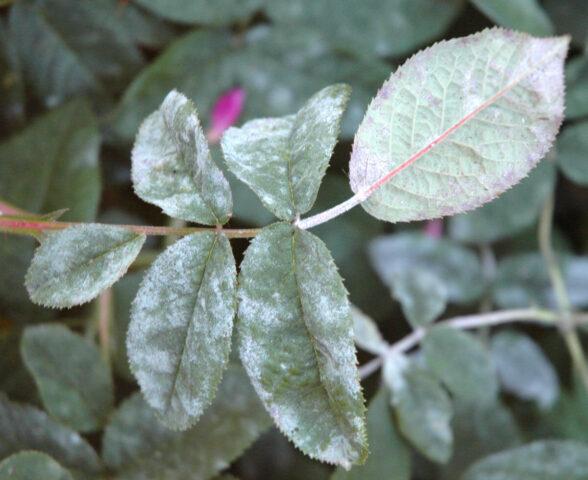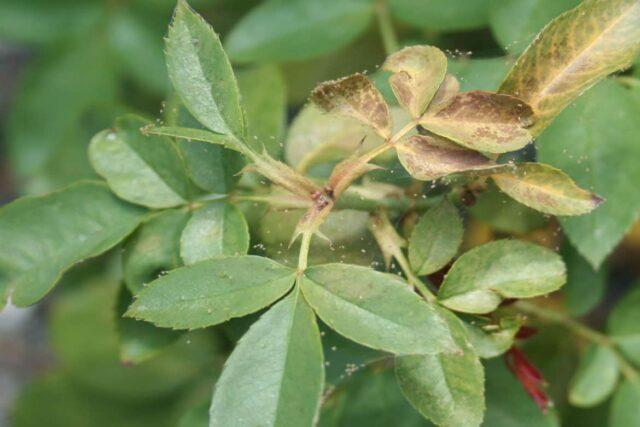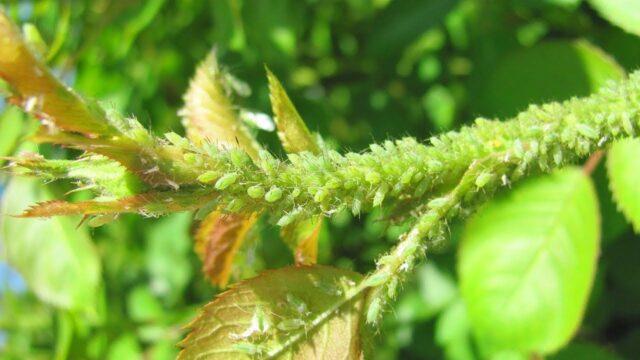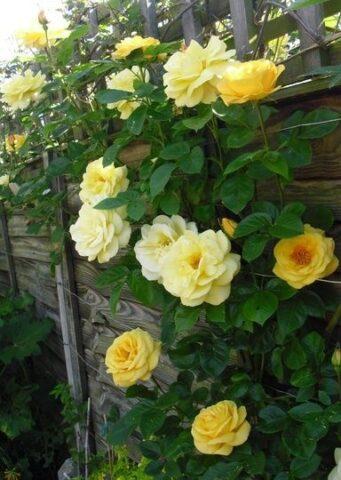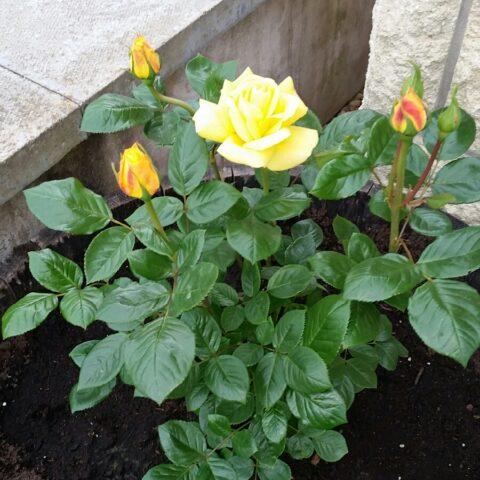Content
Arthur Bell yellow standard rose is considered one of the longest flowering and beautiful ornamental plants. The Arthur Bell variety belongs to the classic standard shrub, since the bush has one main shoot. The culture is grown everywhere, used for decoration of any stylistic direction in landscape design.
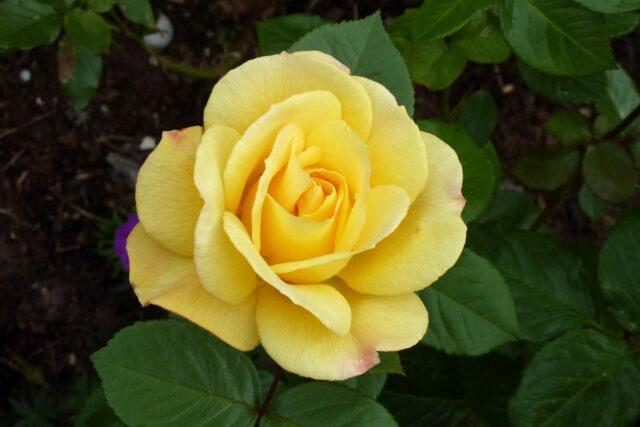
Due to its rapid fading in sunny and hot weather, Arthur Bell is grown mainly in the countries of northern Europe and the UK.
Breeding history
Floribunda rose Arthur Bell (Arthur Bell) obtained as a result of crossing hybrid tea and polyanthus varieties. Initially, breeders received specimens that bloomed all summer, but did not have a smell. The latter specimens are characterized by an excellent aroma and a long, profuse flowering period.
Arthur Bell standard rose variety was bred in 1955 in Ireland by specialists of the McGredy company.
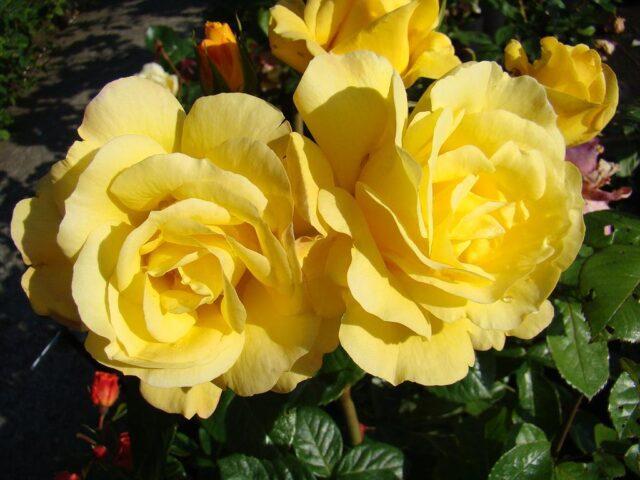
Arthur Bell yellow was specially developed for cultivation in the northern regions of the European part of the continent
Floribunda rose Arthur Bell description and characteristics
Description, photos and reviews of the floribunda rose Arthur Bell allow you to create a general idea of \ u200b \ u200bthe decorative culture. The exquisite garden variety Arthur Bell is characterized by the following properties:
- medium spreading bush, standard, with one main shoot;
- bush height up to 100 cm;
- bush diameter up to 80 cm;
- shoots are strong, thick, well leafy, with a large number of thorns;
- the color of the shoots is dark green;
- the size of the shoots up to 100 cm;
- leaf plates are large, leathery, with pointed tips, with well-distinguishable veins;
- the color of the leaves is shiny, dark green, dark emerald;
- flower shoots are thorny, hard, thick, with racemose inflorescences;
- the number of flowers on the stem is from one to six;
- flowers are semi-double, large;
- flower diameter up to 10 cm;
- the color of the petals is bright yellow, golden, with a yellow tint in the central part and a cream tint around the edges (when the petals burn out in the sun, the color of the petals changes to lemon-cream);
- the number of petals is from 19 to 22 pieces;
- the color of the stamens is crimson;
- fruity aroma;
- flowering period from early June to early November.
The plant is distinguished by winter hardiness, frost resistance (up to - 30 ⁰С), resistance to rain, early flowering.
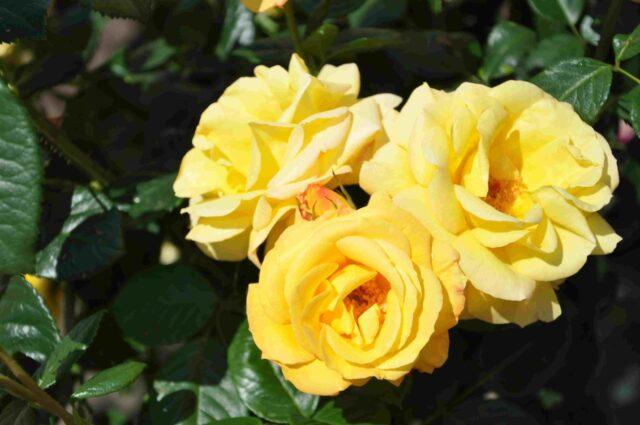
Numerous golden flowers of the standard floribunda rose Arthur Bell are re-flowering plants
Advantages and disadvantages of the variety
Rose Arthur Bell (Arthur Bell) is distinguished by the following advantages, which are inherent exclusively in this standard frost-resistant variety:
- a high degree of decorativeness, which is provided due to the exquisite shape of the bush and the bright color of the petals;
- long flowering (about six months);
- strong, pleasant aroma with tangible fruity notes;
- high level of resistance to cold, frost;
- high level of resistance during the rainy season;
- high level of resistance to the effects of diseases and pests.
In addition to its advantages, the Arthur Bell floribunda rose variety has its own "disadvantages":
- burning out of petals in the sun with a loss of decorative effect;
- a large number of thorns on the shoots, which greatly complicates the care process;
- the need for winter shelter for rose bushes in some northern regions.

Rose Arthur Bell produces buds about three times in the summer season
Reproduction methods
Rose yellow standard floribunda Arthur Bell propagates in the following ways: seed; vegetative.
There are several vegetative propagation methods for the decorative rose Arthur Bell:
- graft;
- dividing the bush;
- grafting.
Rooting of cuttings is most often used at home. For propagation by cuttings, shoots up to 8 cm long are harvested. Cuttings are cut from a healthy mother bush with a processed knife at an acute angle. For some time, the planting material is placed in growth stimulants. After the roots appear, the cuttings are transplanted for complete rooting in greenhouse conditions. After the plants take root, they are transplanted to a permanent place.
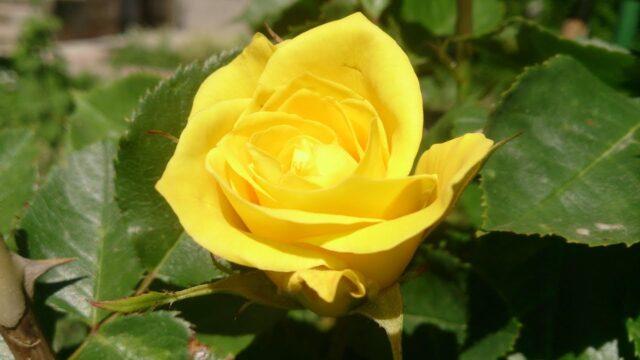
The seed method of propagation of the rose Arthur Bell is used by breeders
Growing and care
Perennial yellow standard rose floribunda Arthur Bell (Arthur Bell) does not require complex agricultural techniques. In order to grow a beautifully flowering bush, you must follow the simple rules of growing and care.
Seat selection
The decorative standard rose Arthur Bell prefers well-lit, wind-protected areas of the garden, located on a flat surface or a slight rise. In the shade of trees, the flowering will not be so intense.
Soil composition
The optimal soil composition for Arthur Bell is fertile, neutral, loose loam or black earth.
Boarding time
Transplanting Arthur Bell yellow rose floribunda saplings outdoors is best done in the spring. The landing site is prepared in advance: the beds are dug up and the plant fragments are carefully removed.
Landing algorithm
Arthur Bell rose seedlings are carefully placed in the prepared holes. Before planting, the existing shoots are shortened to 30-40 cm in length. The root system is cut, leaving up to 30 cm.
One hour before transplanting, rose seedlings with an open root system are placed in a nutrient solution.
Planting holes are formed with a size of 50x50 cm. The bottom of the hole is filled with a layer of broken brick, crushed stone or gravel to create a drainage effect. A mound of nutrient substrate (a mixture of equal parts of humus and superphosphate) is laid on top.
The roots of the seedlings are placed in the center of the prepared mound in the planting hole, straightened and sprinkled with earth. The planting site is abundantly moistened and mulched.
Basic care
Standard yellow floribunda rose Arthur Bell is undemanding to care and unpretentious. Compliance with the basic rules and techniques of agricultural technology will allow you to achieve abundant flowering and protect the ornamental plant from the appearance of dangerous diseases and pests.
Watering
A regular and active watering regime is necessary for the standard rose Arthur Bell during the period of growth of green mass and the appearance of buds. Watering frequency is once a week. To moisturize the plants, it is necessary to use settled water. Rose bushes should be watered at the root, avoiding moisture on the stems and foliage.
At the beginning of the autumn period, it is recommended to completely stop watering.
Feeding
Top dressing of the standard yellow rose Arthur Bell is produced starting from the second year of plant life, since a sufficient amount of mineral and organic fertilizers is applied to the planting holes during transplantation.
Feeding scheme:
- first feeding in early spring;
- second feeding during the budding period;
- subsequent feeding - once every 30 days.
Fertilization should be done after the next watering.
Pruning
Perennial rose bushes Arthur Bell need pruning to give a beautiful decorative shape. The procedure for removing rotten, dried shoots, leaves is a good prevention of pests and diseases.
In early spring, all dry, frozen, damaged shoots are removed from the bush. In the summer, you should cut off the fading buds in a timely manner. Sanitary pruning of bushes is shown in autumn.
Preparing for winter
Preparatory measures for the winter period allow you to maintain healthy and viable Arthur Bell rose bushes for the next growing season:
- shoots are cut to a height of 30 cm;
- dug up the near-stem space;
- potassium-phosphorus mixtures are introduced into the near-trunk circles;
- near-trunk circles are mulched with a layer of sawdust (up to 25 cm thick);
- from above the bushes of roses are covered with spruce branches.
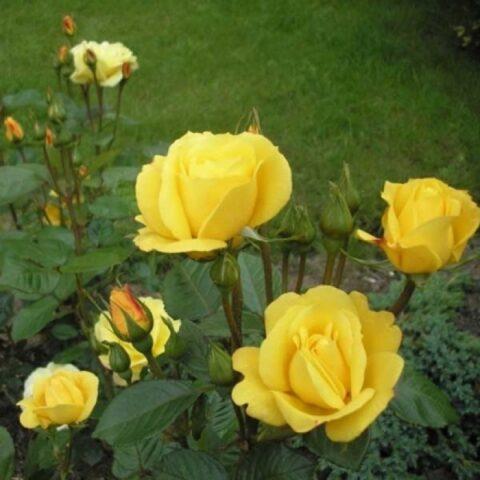
In regions with harsh winters, rose bushes can be covered with agrofibre or other suitable raw materials.
Pests and diseases
Among the diseases of the yellow standard rose floribunda Arthur Bell, which most often affect the bushes of ornamental culture, the following are common:
- Powdery mildew pathogens - mushrooms of the genus Sphaerotheca pannosa. Massive damage to foliage occurs at the height of dry summer. The leaves curl, dry out, and the stems are covered with a white bloom.
Fundazol, Topaz, Fitosporin-M preparations can effectively fight powdery mildew spores
- Black spotb, or marsonina, manifests itself in the case of the defeat of rose bushes Arthur Bell by the fungus Marssonina rosae. The disease manifests itself in early spring by the appearance of rounded or stellate spots of a dark brown, purplish-white color, which eventually turn black. The foliage falls off, the plant loses its frost resistance property.
For black spot, treatment with zinc or manokoceb containing fungicides Skor, Topaz, Profit Gold is effective
Among the pests that parasitize on the standard rose floribunda Arthur Bell, one can distinguish:
- Spider mite - an arachnid insect that most often settles in rose gardens in hot, dry weather from + 29 ⁰С. The pest manifests its existence by the appearance of light spots on pink leaves, which subsequently dry out and fall off.
To combat insects, spider mites use colloidal sulfur, Iskra-M, Fufanon
- Aphid Is a common pest that multiplies intensively throughout the summer. Insects deprive plants of vitality, as they suck the juices from the stems and buds.
To destroy aphids, folk methods are used (treatment with soapy water, wood ash, ammonia)
Application in landscape design
Floribunda rose Arthur Bell Arthur Bell is appreciated by landscape designers everywhere. An ornamental plant has been successfully used for various purposes:
- for decorating gazebos and other small architectural forms;
- for decorating mixborders, beds, flower beds, borders in group compositions;
- in single landings;
- for the design of prefabricated rose gardens.
Yellow roses are in perfect harmony with other varieties of decorative "flower queens". The most relevant combinations are Arthur Bell with such terry varieties as white Aspirin Rose, bright peach or pink Jean Cocteau, purple-pink Marie Henriette.
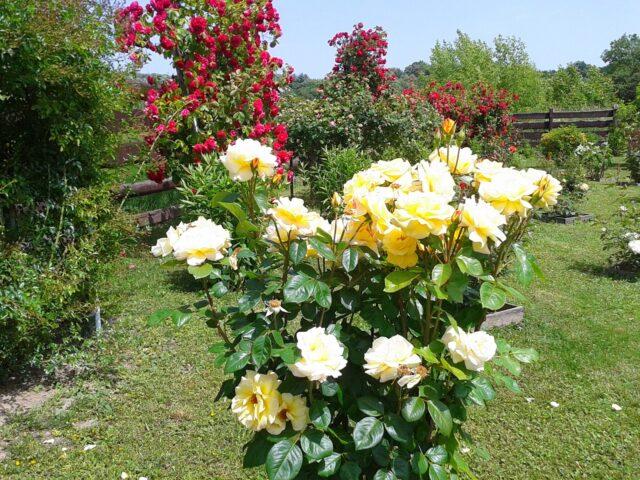
Arthur Bell splendidly coexist with brightly flowering ornamental plants that replace each other throughout the summer
Conclusion
Rose Arthur Bell is a stunning ornamental crop that can be called the champion in bloom duration. The plant begins budding in early June and continues until early November. In total, three flowering periods can be observed during the growing season. The only drawback of the variety is that the golden yellow petals fade in the bright sun, losing their decorative appeal.
Testimonials with a photo of a yellow rose floribunda Arthur Bell

